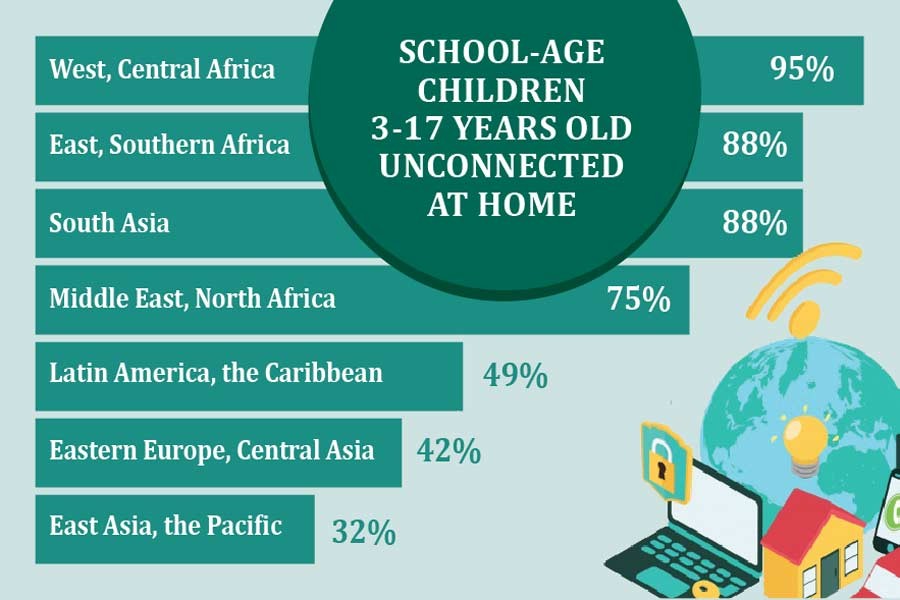Two thirds of the world’s school-age children – or 1.3 billion children aged 3 to 17 years old – do not have internet connection in their homes, according to a report.
The UNICEF and the International Telecommunication Union (ITU) jointly published the report, titled ‘How Many Children and Youth Have Internet Access at Home?, on Tuesday, according to a press release.
The report notes that globally two-thirds of school-age children have no internet access at home. “There is a similar lack of access among young people aged 15-24 years old, with 759 million or 63 per cent of young people unconnected at home,” it says.
According to the Multiple-Indicator Cluster Survey by the Bangladesh Bureau of Statistics in 2019, 62 per cent of the households in Bangladesh do not have internet access at home.
At the same time, this is a national average, and there is a large difference in internet access depending on the households’ socioeconomic backgrounds.
“Only 8.7 per cent of the poorest 20 per cent households in Bangladesh have internet access at home as compared with 75.3 per cent of the richest 20 per cent households,” the report says.
When it comes to television – another main medium for distance learning – the percentage of households owning a television is 51 per cent nationally.
At the same time, only 4.8 per cent for the poorest 20 per cent households own television as compared with 90.2 per cent of the richest 20 per cent of households.
“Children without access to these means of distance learning are bearing the brunt of the digital divide and inequity. They have less access to learning opportunities during the pandemic, putting their education and future in jeopardy,” said Tomoo Hozumi, UNICEF Representative in Bangladesh.
“This divide exacerbates the pre-existing inequalities. It can perpetuate the vicious cycle of poverty and disparity from one generation to the next, with children becoming its transmission belt,” the UNICEF representative added.
Around 42 million children are affected by COVID-19 school closures in Bangladesh. For those with no access to the internet or TV, education can effectively be out of reach.
Even before the pandemic, a growing cohort of young people needed to learn foundational, transferable, digital, job-specific and entrepreneurial skills to compete in the 21st-century economy.
The digital divide is perpetuating inequalities that already divide countries and communities, the report notes.
Children and young people from the poorest households, rural and lower-income states are falling even further behind their peers and are left with very little opportunity to ever catch up.
Globally, among school-age children from the richest households, 58 per cent have an internet connection at home, compared with only 16 per cent from the poorest households.
The same disparity exists across country income level as well. Less than 1 in 20 school-age children from low-income countries have an internet connection at home, compared with nearly 9 in 10 from high-income countries.
There are also geographic disparities within countries and across regions.
Globally, around 60 per cent of school-age children in urban areas do not have internet access at home, compared with around three-quarters of school-age children in rural households. School-age children in sub-Saharan Africa and South Asia are the most affected, with around 9 in 10 children unconnected.
Last year, UNICEF and ITU launched Giga, a global initiative to connect every school and its surrounding community to the Internet. Working with governments, Giga has now mapped over 800,000 schools in 30 countries.
With this data, Giga works with governments, industry, civil sector, and private sector partners to craft compelling investment cases for blended public-private funding to build the connectivity infrastructure needed to deploy digital learning solutions and other services.
The initiative is now collaborating under the Reimagine Education initiative and in coordination with Generation Unlimited. Through its Reimagine Education initiative, UNICEF aims to address the learning crisis and transform education by giving children and young people equal access to quality digital learning. A key to achieving this is universal internet connectivity.
Building on these efforts and on the importance of youth engagement, Generation Connect is an initiative launched by ITU to empower young people to engage and participate in the digital world.
Although the numbers in the UNICEF-ITU report present an alarming picture, the situation is likely worse due to compounding factors, such as affordability, safety and low levels of digital skills.
According to the latest ITU data, low digital skills remain a barrier to meaningful participation in a digital society, while mobile telephone and internet access remain too expensive for many in the developing world as the result of vast disparities in purchasing power.
Even when children have a connection at home, they may not be able to access it because of the pressure to do household chores or to work, lack of sufficient devices in the households, girls being permitted less or no internet access, or a lack of understanding of how to access opportunities online. There are also issues related to online safety since parents may be inadequately prepared to keep their children safe.


